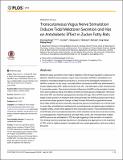| dc.contributor.author | Wang, Shuxing | en_US |
| dc.contributor.author | Zhai, Xu | en_US |
| dc.contributor.author | Li, Shaoyuan | en_US |
| dc.contributor.author | McCabe, Michael F. | en_US |
| dc.contributor.author | Wang, Xing | en_US |
| dc.contributor.author | Rong, Peijing | en_US |
| dc.date.accessioned | 2015-05-04T15:27:39Z | |
| dc.date.issued | 2015 | en_US |
| dc.identifier.citation | Wang, Shuxing, Xu Zhai, Shaoyuan Li, Michael F. McCabe, Xing Wang, and Peijing Rong. 2015. “Transcutaneous Vagus Nerve Stimulation Induces Tidal Melatonin Secretion and Has an Antidiabetic Effect in Zucker Fatty Rats.” PLoS ONE 10 (4): e0124195. doi:10.1371/journal.pone.0124195. http://dx.doi.org/10.1371/journal.pone.0124195. | en |
| dc.identifier.issn | 1932-6203 | en |
| dc.identifier.uri | http://nrs.harvard.edu/urn-3:HUL.InstRepos:15034973 | |
| dc.description.abstract | Melatonin plays a protective role in type 2 diabetes (T2D) through regulation of glucose metabolism. Whether transcutaneous vagus nerve stimulation (taVNS) is antidiabetic and whether a modulated melatonin production is involved in the antidiabetic mechanism of taVNS is unknown. In this study, once daily 30min noninvasive taVNS was administered in Zucker diabetic fatty (ZDF, fa/fa) and Zucker lean (ZL, +/fa) littermates under anesthesia for 5 consecutive weeks. The acute and chronic influences of taVNS on the secretion of melatonin were studied as well as the effects of taVNS on blood glucose metabolism. We found that naïve ZDF rats develop hyperglycemia naturally with age. Each taVNS session would trigger a tidal secretion of melatonin both during and after the taVNS procedure and induce an acute two-phase glycemic change, a steep increase followed by a gradual decrease. Once daily taVNS sessions eventually reduced the glucose concentration to a normal level in seven days and effectively maintained the normal glycemic and plasma glycosylated hemoglobin (HbAlc) levels when applied for five consecutive weeks. These beneficial effects of taVNS also exist in pinealectomized rats, which otherwise would show overt and continuous hyperglycemia, hyperinsulinemia, and high HbAlc levels. We concluded that multiple taVNS sessions are antidiabetic in T2D through triggering of tidal secretion of melatonin. This finding may have potential importance in developing new approaches to the treatment of T2D, which is highly prevalent, incurable with any current approaches, and very costly to the world. | en |
| dc.language.iso | en_US | en |
| dc.publisher | Public Library of Science | en |
| dc.relation.isversionof | doi:10.1371/journal.pone.0124195 | en |
| dc.relation.hasversion | http://www.ncbi.nlm.nih.gov/pmc/articles/PMC4400163/pdf/ | en |
| dash.license | LAA | en_US |
| dc.title | Transcutaneous Vagus Nerve Stimulation Induces Tidal Melatonin Secretion and Has an Antidiabetic Effect in Zucker Fatty Rats | en |
| dc.type | Journal Article | en_US |
| dc.description.version | Version of Record | en |
| dc.relation.journal | PLoS ONE | en |
| dc.date.available | 2015-05-04T15:27:39Z | |
| dc.identifier.doi | 10.1371/journal.pone.0124195 | * |
| dash.authorsordered | false | |


